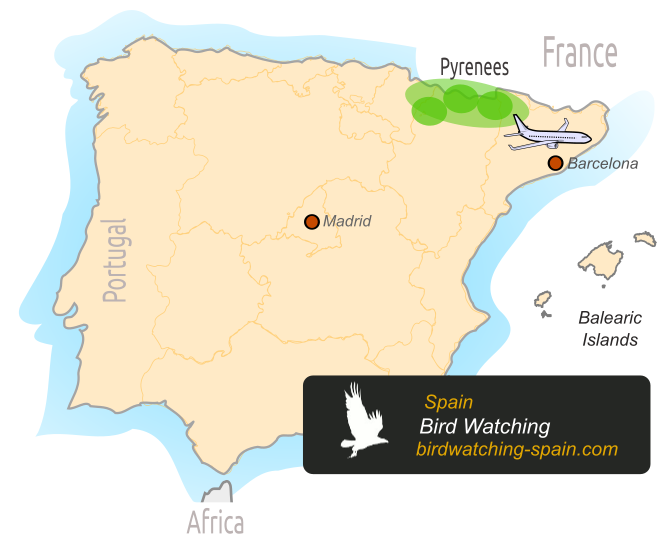Birding in Pyrenees, at Northeast Spain
Adventuring into the Pyrenees mountains in the northeastern corner of Spain gives the traveler many great opportunities for birding. The sloping and dramatic topography of the region means that many species are endemic to the area.

Griffon Vulture at Pyrenees. Photo by Luc Viatour (CC BY-SA 2.0)
Birds of prey
The mountains and valleys of the Spanish Pyrenees are home to many birds of prey, including one of Europe’s largest and rarest vulture, the lammergeier or bearded vulture.
The lammergeier has a wingspan of up to 2.8m (9ft), and is one of the few vultures without a bald head.
The lammergeier scavenges mainly on bone marrow. This bearded vulture carries large bones high into the air and drops them, spiraling down in flight to feed on the cracked bones. This behavior takes young birds years to master and is a treat for birders to watch.
Other large birds of prey include the griffon vulture, the golden eagle, and the beautiful white and speckled short-toed eagle.
Small birds
The citril finch is a small yellow songbird that birdwatchers can spot in the Pyrenees.
The wallcreeper can be seen guarding its territory on rock faces, eating insects from cracks in the mountain walls.

Barn Owl at Pyrenees. Photo by Kurt Kulac (CC BY-SA 2.5)
The crow-like alpine chough and red-billed chough glide by at the higher altitudes.
At the highest peaks, birders can find the small alpine accentor and the fearless sparrow-like snowfinch.
Nuthatches, bullfinches, the tiny crested tit or the fascinating barn owl are also found in the woods.

Barn Owl at Pyrenees. Photo by Luc Viatour (CC BY-SA 2.0)
Summer
Summer in the mountains in Pyrenees brings greater numbers of rock thrush, red-backed shrikes, and water pipit.
The water pipit has a distinct pink plumage in the summer breeding season.

Griffon Vulture at Pyrenees. Photo by Bruno Bord (CC BY-SA 2.0)
Birdwatchers can spot the short-toed treecreeper hopping up and down trees looking for insects.
The Egyptian vulture also migrates up to Spain from Northern Africa in the summertime.
The adult Egyptian vulture is a white majestic bird that hunts as well as scavenges, and it also uses tools like pebbles and twigs to hammer open its food or to make its nest.
Where to hike
If you like sport and adventure the GR11 trail, also known as the Pyrenean Trail, runs throughout the Pyrenees east to west.
It begins in Cape Higuer in Basque Country, crosses through the beautiful regions of Navarre and Aragon, and finishes at the Cap de Creus in Catalonia.
The entire 840km (522 miles) path can take up to 40 days, but birders can take segments and day hikes along this clearly marked trail through the mountains to make their own trek. Hikers can stay overnight in different towns close to the path, including the spa town of Panticosa.
Yes, for normal people there are a lot of birding tours and guided trips from Navarra, Aragon, Catalonia.. They can organise private tours to the best zones.
Where to watch birds
There are many many places to practice birdwatching as Pyrenees is a wide area.

Ordesa and Monte Perdido National Park with impressive mountain and valley landscapes.
The valleys of Anso and Hecho near Jaca.
The valley of Benasque or Sierra de Guara between Huesca and Sabinanigo.
Trips and guides in Pyrenees
Boletas Birdwatching Center
Accommodation, information and selection of very well organised tours through Spain.
More info at: birdingspain.com
Spainbirds
Many birding tours along Spain
More info at: spainbirds.com
Birdingpyrenees.com
Rustic holidays homes in Huesca, near the best birdwatching spots in Pyrenees. They also organise birding tours in Spain with the Dutch company ARAGON Natuurreizen
More info at: birdingpyrenees.com
Pyrenean Odysseys
Guided walks and treks, private guiding. Bird Watching in the Vallées des Gaves (south of Lourdes to the Spanish border) and the Hautes Pyrenees
More info at: pyrenees-mountains.com
